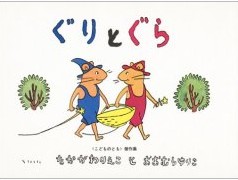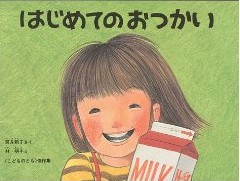Often as I am reading a picture book to my daughter she points out to me some subtlety of the picture that I missed because I was reading the words. Then I recall an observation made by Tadashi Matsui, an editor of children's literature in Japan for over fifty years: "Only by having a picture book read aloud to you can you experience the full effect of the words and pictures together."
Before hearing this insight, I always assumed that when I read a picture book to children, their experience of the book and my experience of the book were essentially the same. However, after hearing Mr. Matsui's words, I began to notice where my child's eyes were as I read a page. I had more patience for reading the same story two or three times in a row; after the initial read through at a sitting we would read again, taking time to discuss the pictures or storyline. Now my daughter points out to me parts of the story that appear only in the pictures, not in the words, because she knows I miss these parts sometimes.
Conference theme and venue
Last year at the end of August I had the good fortune to attend the five-day meeting of the International Research Society for Children's Literature (IRSCL) at which Tadashi Matsui made this observation in his keynote address titled "Picture Books: Past, Present and Future," which was also the theme of the conference. It was the first time for the biennial congress to be held in Asia, and the proceedings took place at the beautiful Kyoto International Conference Center facilities in the northern part of Kyoto City, Japan.
The conference planners used their location to their advantage, offering optional excursions to the newly established Kyoto International Manga Museum and the International Institute for Children's Literature at Expo Park in Osaka, both of which are unique resources even for people living in Japan, and more so for the many convention attendees from abroad. Many researchers in children's literature were able to come from Australia and Asian countries to present their findings at this meeting since the Kyoto location was very convenient for those in the Pacific region. Attendees from abroad that I spoke with, especially those from Australia and New Zealand, seemed happy that another Western Pacific Rim location took the initiative to hold the annual congress, giving them the opportunity to discover another country and its contribution to children's literature without having to travel to the East Coast of the United States or Europe.
Tadashi Matsui's overview of Japanese children's literature
Mr. Matsui opened his keynote speech to the benefit of his international audience with a brief overview of illustrated stories throughout Japanese history. Though I studied Japanese art history in college and was familiar with most of the works he touched on, I had never considered the relationship between the historical e-maki, or picture scrolls, and modern-day children's literature. Specifically, Mr. Matsui mentioned the 12th Century Shigisan Engi and the Choju Jinbutsu Giga
http://www.suntory.com/culture-sports/sma/exhibition/07vol04/index.html, with its use of animals (the rabbit and frog) personified as the main characters in the same way animals are often the main characters in children's stories. He suggested considering e-maki as the start of children's literature in Japan and also suggested that the now worldwide-popular Japanese anime movement grew out of that Japanese children's literature. It was a revolution for me to think about anime evolving from e-maki, with children's literature in picture books as a key steppingstone in between.
Mr. Matsui then went on to discuss the important points along the timeline of children's literature publishing in Japan. In the 1910s and 1920s, several important magazines for children's literature were established: Kodomo no Tomo, Akai Tori, and Kodomo no Kuni. The 1950s marked another crucial stage where there was active foreign exchange with other countries in the area of children's literature, with the publishing of such classic books as Curious George, The Little House, and Little Black Sambo in Japanese. The 1950s was also when the classic Japanese stories Guri to Gura (Guri and Gura) and Hajimete no Otsukai (Miki's First Errand) initially appeared in Kodomo no Tomo magazine, according to Mr. Matsui.
 |
Guri to Gura, Rieko Nakagawa and Yuriko Yamawaki, Hukuinkan Shoten, 1967 |
 |
Miki's First Errand, Yoriko Tsutsui and Akiko Hayashi, Hukuinkan Shoten, 1977 |
These books are still widely read today and have been translated into other languages.
The mention of these books made me think of my own daughter, as these are two of her favorite stories, ones that we read again and again. It surprised me that the stories were so old. They hardly seem dated; although there is an innocence about them that makes me feel nostalgic, their classic quality allows even today's children to identify strongly with the characters. However, it still surprised me that when people gave books to my daughter as a gift, or when her teacher read to her class at nursery school, that these stories would be chosen over more recently published material. So when the question session began, I raised my hand and asked Mr. Matsui - quite pointedly I am afraid - if it was some incredible timeless quality these authors had achieved that accounted for this continued popularity over and above contemporary publishing, or if it was simply that nothing good was being produced now. In fact, my question was completely tactless as the next speaker was just such a contemporary author, but in my ignorance I put Mr. Matsui in this exceptionally awkward situation, and to his credit he managed a very graceful answer to my question that I interpreted to mean "a bit of both".
The commercialization of children's literature
In any case, I also asked Mr. Matsui about the commercialization of characters from these books. As a parent, I am always being pressed by my child to buy the ubiquitous "character goods," those items of daily life that have a picture of a figure from a favorite story or movie on them. In Japan, as elsewhere around the world, children can - and do - covet everything from notebooks to knapsacks, from toothbrushes to umbrellas, with these characters on them. One child in my daughter's Japanese nursery school even has Thomas the Train chopsticks. Surely the Reverend Awdry, creator of Thomas the Train, could never have envisioned this in 1942 when he started the series!
I admit that I had fallen in love a bit with Guri and Gura, those two simply drawn mice who have endless adventure in the woods and also happen to be gourmet cooks. If I could find stationery goods or a t-shirt in my size picturing them, I would probably buy it even for myself. So I asked Mr. Matsui if he knew why there were only calendars or postcards available of Guri and Gura, or of the lovely girls who populate the stories of Akiko Hayashi, like Kon to Aki (Aki and the Fox, subsequently published as Amy and Ken Visit Grandma) and Hajimete no Otsukai (Miki's First Errand).
It turns out that the commercialization of children's literature is an important field of research right now, and several talks at the conference either had the topic as their focal point or touched on the subject (IRSCL Part II will be posted on Oct. 31), but given the limited time for questions and answers between the opening speeches, Mr. Matsui gave an answer that was direct and straightforward. He said he knew the authors and illustrators involved, and in at least one case the lady who had created these wonderful characters was quite opinionated on the matter and would not be swayed by any arguments (or amounts of money, I assumed) that she should allow her creations to be commercialized in the way most others have. He was smiling as he said it, and I could see the great respect he had for these writers and illustrators he had worked with as an editor, and the values that they represented and upheld.
Values demonstrated by some uncommercialized books
As I considered his answer, I realized that exactly this quality was what made these stories such classics. There is something in the characters and in the stories themselves that speaks to us of values that transcend money and the material world, that go beyond the kind of competition and absolute sense of "right" verses "wrong" that seem to permeate more recent media directed at children. Perhaps such can be said for other books, but when Guri and Gura make a cake in the forest, it is assumed that of course the other animals will join them in eating it; the question of who worked to make the cake and therefore who is entitled to eat it, is mute. Issues such as whether there be enough for everyone (here, all the forest animals) and other materialistic and competitive concerns that seem to appear in many tales do not play any part in the story. When the girls in Akiko Hayashi's books run into their dilemma, there is no force of evil that they are battling. There is no "bad guy" for them to compete against. They are simply resourceful and powerful little girls who think clearly and carefully without panicking and act decisively to solve their problem (recover a lost doll, navigate city streets, etc.) and work their way through the adventure of the story. I hardly assume to be qualified enough to assert that these are the qualities that make classic Japanese picture books, but I know that they are the qualities that make me want to read them to children again and again, and that make me feel good about it every time I do.
(Mr. Matsui's speech was given in Japanese. Translations are my own and I take full responsibility for any mistakes.)














